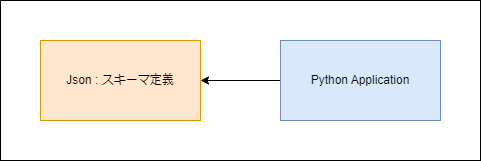はじめに
この記事では、JSON形式でスキーマを定義して、PyDanticのクラスを作成する方法を2つ紹介します。
- 型名と引数を書いたJSONをPyDanticのクラスに変換する
- JSONSchema形式で書いたJSONをPyDanticのクラスに変換する
どういうメリットと、どういうメリットがあるの?
JSONで定義するメリットとしては、定義をアプリの外部に置くことができるので、
- 利用者の数が変わる昼と夜で閾値を変えたい
- クラウド側に定義ファイルを置きたい
といった要望があった時に対応できることが考えられます。
デメリットとしては、IDEから定義が全く見えないせいで自動補完が効かず、ツールとしての恩恵を受けにくいことです。
型名と引数を書いたJSONをPyDanticのクラスに変換する
この方法では、スキーマには、
- 型の名前(キー名: type, str型)
- Fieldクラスに渡す引数(キー名: attribute, dict型)
を定義します。
バリデータとして、以下のようなJSONファイルを作成しました。
{
"user_name": {
"type": "str",
"attribute": {"min_length": 1, "max_length": 8},
},
"role_number": {
"type": "int",
"attribute": {"ge": 1, "le": 9},
},
"group_number": {
"type": "int|None",
"attribute": {"ge": 1, "le": 4},
},
}
読み込む関数は以下のように定義します。
import json
from pydantic import BaseModel, create_model, Field
class DataType(BaseModel):
""" スキーマを解釈するクラス """
type: str
attribute: dict
def json_to_pydantic(schema_data: str):
""" JsonをPyDanticの型に変換します """
fields = {}
# Json文字列を読み込んでオブジェクトに変換する
schema: dict = json.loads(schema_data)
# キーを配列で取得する
for key in schema.keys():
define = DataType.parse_obj(schema[key])
fields[key] = (
define.type, # strやintの文字列を渡すと型名として解釈される
Field(**define.attribute), # Fieldの設定値を渡す
)
# PyDanticのモデルを作成する
return create_model("Model", **fields)
作成した関数を使ってみます。
# JSONファイルを読み込んで、Pydanticのデータ型に変換する
with open("schema.json") as fp:
cls = json_to_pydantic(fp.read())
# parse_objで値をバリデートする: 正常なケース
result = cls.parse_obj({"user_name": "User", "role_number": 8, "group_number": 2})
print(result) # >> 出力: user_name='User' role_number=8 group_number=2
# parse_objで値をバリデートする: 正常なケース
# group_numberの許容型はint|Noneなので、Nullは許容される
result = cls.parse_obj({"user_name": "User", "role_number": 8})
print(result) # >> 出力: user_name='User' role_number=8 group_number=None
# parse_objで値をバリデートする: エラーになるケース
# role_numberの許容型はintなので、Nullは許容されない
result = cls.parse_obj({"user_name": "User", "group_number": 2})
print(result) # >> 出力: field required (type=value_error.missing)
# parse_objで値をバリデートする: エラーになるケース
# group_numberの許容型はint|Noneなので、文字列型は許容されない
result = cls.parse_obj({"user_name": "User", "role_number": 8, "group_number": "two"})
print(result) # >> 出力: value is not a valid integer (type=type_error.integer)
# parse_objで値をバリデートする: エラーになるケース
# group_numberの範囲は1~4、9は上限を超えている
result = cls.parse_obj({"user_name": "User", "role_number": 8, "group_number": 9})
print(result) # >> 出力: ensure this value is less than or equal to 4 (type=value_error.number.not_le; limit_value=4)
JSONSchema形式で書いたJSONをPyDanticのクラスに変換する
もう一つは、JSONSchema形式のJSONを読み込む方法です。
datamodel_code_generatorが必要になるので、pipでインストールしておきます。
pip install datamodel-code-generator
以下のようにスキーマを定義します。
{
"$schema": "http://json-schema.org/draft-07/schema#",
"title": "Person",
"type": "object",
"properties": {
"firstName": {
"type": "string",
"description": "The person's first name."
},
"lastName": {
"type": "string",
"description": "The person's last name."
},
"age": {
"description": "Age in years which must be equal to or greater than zero.",
"type": "integer",
"minimum": 0
},
"friends": {
"type": "array"
},
"comment": {
"type": "null"
}
}
}
datamodel_code_generatorでJSONSchemaを実行する処理は別ファイルに切り出します
from datamodel_code_generator import generate
from pathlib import Path
from sys import argv
print(generate(Path(argv[1]), input_file_type="jsonschema"))
処理は以下のように定義します
from subprocess import run, PIPE
def read_from_json(json_name: str):
""" JSONSchemaをPyDanticのクラスに変換する処理を実行する """
cmd = f"python subproc.py {json_name}"
# 結果は標準出力で受け取ります
return run(cmd, capture_output=True, text=True).stdout
def global_to_class(class_name: str):
""" Global変数から対象のクラスを受け取ります """
if class_name in globals():
return globals()[class_name]
return None
実行は以下のように行います
exec(read_from_json("person.json"))
cls = global_to_class("Person")
if cls is not None:
print(cls.parse_obj({"firstName": "Jane", "lastName": "Doe"}))
# 実行結果: firstName='Jane' lastName='Doe' age=None friends=None
JSONSchemaをクラスに変換する処理をサブプロセス上でやる、結果を標準出力で受けてexec関数に渡す、実行結果がglobalsの変数に格納されるのでそこから対象のクラスを読み出す、といった形になります。
※execはルートで実行します
関数内で実行するとglobalsではなくlocalsに格納されますが、「pydantic.errors.ConfigError: field "firstName" not yet prepared so type is still a ForwardRef, you might need to call Person.update_forward_refs().」のエラーが出て実行できません
まとめ:実現できないわけではないけれども
おとなしくCerberus使ったほうが楽です…
